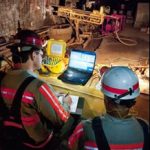3rd Mine Ventilation Symposium, Pennsylvania State University, University Park, Pennsylvania, October 1987
Authors: M. E. Adam (Tenn-Luttrell, Inc.), C. E. Brechtel and J. F. T. Agapito (AAI), and E. D. Thimons (USBM)
Full-scale stopping and simulated overcast structures were constructed in large opening (30-ft high by 55-ft wide) room-and-pillar excavations in an oil shale mine. The program was undertaken to develop construction techniques and to generate data on structure costs and leakage rates. Leakage rates were measured using both sulfur hexafluoride tracer gas and “brattice window” methods at varying differential pressures. The measurements were conducted before and after a full-scale face blast to characterize the effects of blasting on leakage, and blast air pressures were measured across the stoppings. The operating performance of different combinations of permanent and temporary stoppings was evaluated by developing an operating model for a two-panel oil shale mine. The operating performance for the different stopping combinations was then compared to the system cost to evaluate the overall performance.





